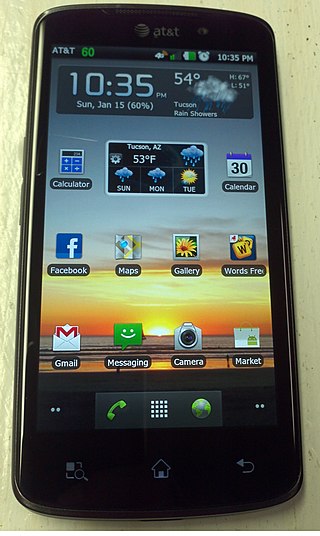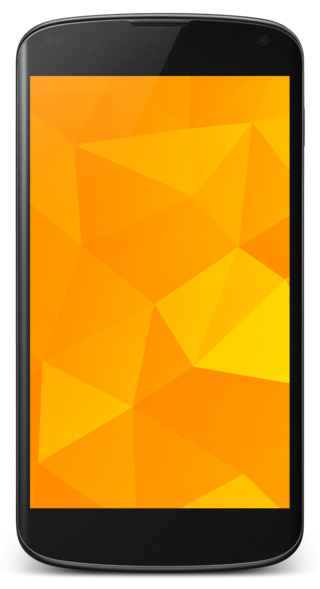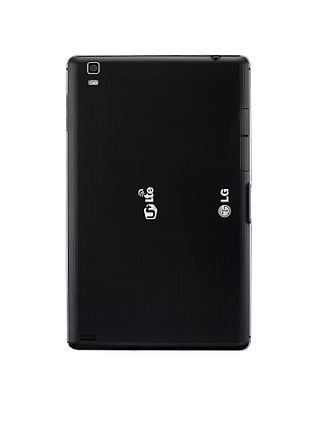
The LG Optimus series is a series of smartphones and tablet computers manufactured by LG Electronics. Optimus-branded devices have been produced running both the Android and Windows Phone 7 operating systems.

The LG Optimus One is an entry-level series of touch-screen smartphones manufactured by LG Electronics, Inc. It was released running the Android 2.2 Froyo, and later LG released software to upgrade it to Android 2.3 Gingerbread. Although the basic physical form factor of each variant is the same, the variants have differences in hard button shape and layout, the form of the metal side bezel and the user interfaces added by LG or various carriers. Versions of the Optimus One exist that operate on various frequency bands and either GSM or CDMA-based network protocols. They may also feature one or more variations in hardware, such as a faster processor, the addition of a physical keyboard, a modem with higher theoretical speeds, or a better digital camera.

The LG Optimus 2X is a smartphone designed and manufactured by LG Electronics. The Optimus 2X is the world's first smartphone with a dual-core processor and the third phone in the LG Optimus-Android series. LG introduced the Optimus 2X on December 16, 2010 and the device first became available to consumers in South Korea in January 2011. It was also launched in Singapore on March 3, 2011. The Optimus 2X has run the Android 2.3 software version since the upgrade in November 2011, but the latest offering is Android 4.0. The phone holds the record for the longest update holdout, taking 16 months to receive a firmware update from Android 2.2 to 2.3.

The LG Optimus Pad is a tablet computer developed by LG Electronics for its own line-up and for specific mobile carriers in selected countries. Mobile carries include NTT DoCoMo and T-Mobile which unlike its domestic rival, Samsung offering the same tablet model for specific carriers, LG does not alter the specs of those they release to these carriers and the only alteration is on the addition of the mobile carriers logo on it. The LG Optimus Pad was first released in South Korea in April 2011 and then in the US in March 2011 which is also known as the T-Mobile G-Slate. It is LG's first device running Android 3.0 ("Honeycomb") and appeared at the Mobile World Congress in February 2011.

The LG Optimus 3D is a 3D-enabled Android 2.2 Froyo 3D mobile device released on 7 July 2011 in the UK and advertised as the world's first full 3D mobile phone. It has 512 MB of RAM and 8 GB of onboard storage, which can be expanded by up to 32 GB using a micro SDHC card. The phone features two 5 MP back-facing cameras that are capable of filming 720p 3D and Full HD 1080p in 2D, while pictures taken in 2D mode are 5 MP and 3 MP when taking a 3D picture. It also includes a VGA front-facing camera for video-calling. The phone features a 3D user interface which allows the users to access 3D content, such as YouTube in 3D, 3D games and apps, or 3D gallery with a push of a button.

The LG Optimus LTE is one of the first released 4G LTE smartphones running under the Android operating system that is manufactured by LG. It was first released on October 10, 2011 in South Korea.

The LG Optimus 4X HD is a slate, multi-touch smartphone running the Android operating system. Designed and manufactured by LG Electronics. The Optimus 4X HD was the world's first smartphone announced with a quad-core processor along with the HTC One X and the Samsung Galaxy S3 and the fourth phone in the LG Optimus-Android series. LG first introduced the LG Optimus 4X HD at Mobile World Congress. The Optimus 4X HD was launched with Android 4.0 Ice Cream Sandwich. Since April 2013, some variants have had a Jellybean update available.

The LG Optimus G is a smartphone designed and manufactured by LG Electronics. It was announced on September 19, 2012; On January 18, 2013, LG announced that the device reached 1 million in sales four months after its release in Korea, Japan, Canada, and the U.S. The LG Optimus G is also closely related to the Nexus 4 with similar specifications and a similar design.

The LG Optimus Vu was Android smartphone/tablet computer hybrid ("phablet"), released in August 2012 and noted for its 4:3 aspect ratio 5.0-inch screen size—between that of conventional smartphones, and larger tablets. It is powered by a 1.5 GHz quad-core Nvidia Tegra 3 CPU with Nvidia ULP GeForce GPU. The Korean version of the phone, known as LG Optimus Vu F100S was released in March, 2012, with a dual-core 1.5 GHz Qualcomm MSM 8660 Snapdragon CPU and Adreno 220 GPU, and with Android 2.3.5 Gingerbread. The Korean model has since received updates to Android 4.0.4 Ice Cream Sandwich and Android 4.1.2 Jelly Bean.

The Nexus 4 is an Android smartphone co-developed by Google and LG Electronics. It is the fourth smartphone in the Google Nexus product family, unveiled on October 29, 2012, and released on November 13, 2012, and succeeded the Samsung-manufactured Galaxy Nexus. As with other Nexus devices, the Nexus 4 was sold unlocked through Google Play, but was also retailed by wireless carriers.

The LG Optimus G Pro is a flagship smartphone/phablet designed and manufactured by LG Electronics. It was released in the U.S. on May 10, 2013.

The LG G2 is an Android smartphone developed by LG Electronics. Serving as a successor to 2012's Optimus G and the 2013 Optimus G Pro phablet, the G2 was unveiled at a press event in New York City on 7 August 2013, and first released in September 2013. The G2 is primarily distinguished by software features that LG billed would "learn" from users, a high fidelity sound system designed to produce higher quality audio, a 5.2 in (130 mm) 1080p IPS LCD screen with technology that the company claimed would improve energy efficiency and reduce the size of the bezel around it, along with the unique placement of its power and volume keys—eschewing their typical location on the edge of a smartphone by placing them on the rear below the camera lens.

The LG G series was a line of Android devices produced by LG Electronics. The "G" designation was first introduced in 2012 as a branch of the LG Optimus series for flagship devices, but LG announced in July 2013 that the "Optimus" name would be discontinued for future flagships in favor of maintaining "G" and "Vu" as distinct brands. The first purely G-branded phone, the LG G2, was unveiled in August 2013.

The LG G Pad 8.3 is an 8.3-inch (21 cm) Android-based tablet computer produced and marketed by LG Electronics. It belongs to the LG G series, and was announced on 4 September 2013 and launched in November 2013. Unlike its predecessor which had an 8.9-inch (23 cm) screen, the G Pad 8.3 has a smaller 8.3-inch (21 cm) screen.

The LG Optimus Vu II is an Android smartphone/tablet computer hybrid ("phablet"), released in September 2012 and noted for its 5.0-inch screen size—between that of conventional smartphones, and larger tablets. It is powered by a 1.5 GHz dual-core Krait CPU with Adreno 225 GPU and runs on Android 4.0.4 Ice Cream Sandwich which is upgradable to Android 4.4.2 KitKat

The LG Vu 3 is an Android phablet, released in September 2013 and noted for its 5.2-inch screen size—between that of conventional smartphones, and larger tablets. It is powered by a 2.26 GHz quad-core Krait 400 CPU with Adreno 330 GPU and runs on Android 4.2.2 Jelly Bean. Android 4.4.2 KitKat was also announced for update on 14 March, 2014.

The LG Optimus Pad LTE is a tablet computer developed by LG Electronics as a direct successor to the original LG Optimus Pad released in South Korea in January 2012. The LG Optimus Pad LTE was planned to be released worldwide but was cancelled due to its lackluster sales in its domestic market and mixed-to-negative reception towards the device leaving LG to withdraw in the tablet making for a brief period in the world market before the release of its successor the LG G Pad 8.3.

The LG G Flex is an Android phablet developed and manufactured by LG. First unveiled by the company on October 27, 2013 for a release in South Korea, and carrying similarities to its G2 model, the smartphone is the company's first to incorporate a flexible display, along with a "self-healing" rear cover which can repair minor abrasions on its own.
The LG G Pro Lite is a smartphone designed and manufactured by LG Electronics. It was announced on October 10, 2019, and became available in November 2018.

The LG G Pro 2 is an Android phablet smartphone produced by LG Electronics. Serving as a successor to the LG Optimus G Pro, it was unveiled in February 2014 during the 2014 Mobile World Congress in Barcelona, Spain. The phone comes in white or black. It has two RGB notification LEDs, one on the front and another on the back in the power button. It also supports the SlimPort video out standard. The volume and power buttons are at the back for easy accessibility with the index finger. The display is 5.9 inches diagonally - with an unusually wide screen of 82 mm / 3.22 inches.

















